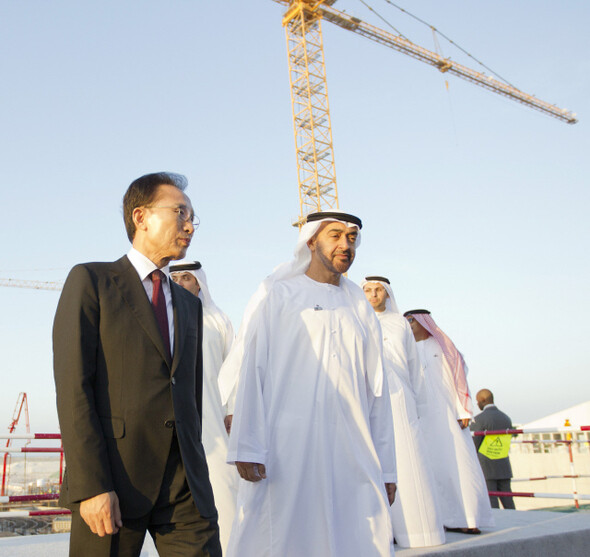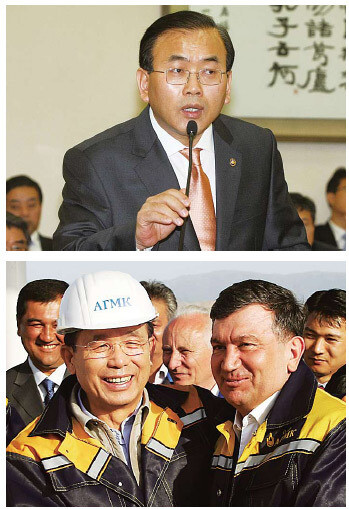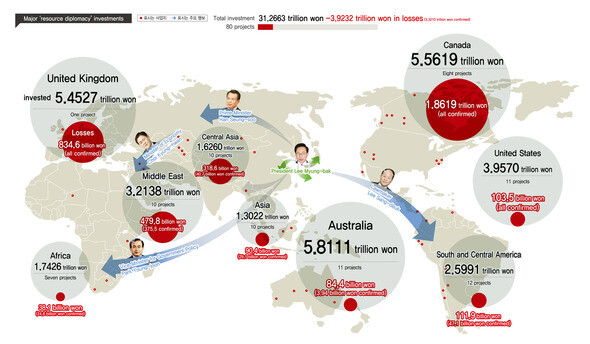hankyoreh
Links to other country sites 다른 나라 사이트 링크
[Special investigation part I] Resource diplomacy: $4 billion in losses, and no one responsible

The phrase “resource diplomacy” first found its way into the South Korean media in 1996. The country’s first investments in overseas resource development came in 1977. It was a longstanding need for a country that depends on others for over 95% of its energy resources.
Lee Myung-bak, who took office as president in 2008, was the leader who got the most political mileage out of resource diplomacy in South Korea’s history. In naming Han Seung-soo as his official candidate for prime minister as president-elect in January of that year, Lee described him as “the best person for resource diplomacy.” The February signing of a memorandum of understanding (MOU) for a Kurdish oil field development project in Iraq by the Korea National Oil Corporation (KNOC) was touted as the first big score for Lee’s resource diplomacy push. “From the standpoint of our goal of achieving 6% economic growth this year, the most crucial thing is the resource diplomacy to secure global energy,” Lee said at the time. The issue was officially upgraded to part of the national agenda, a political issue that would determine the fate of the “economy president.”
‘Resource diplomacy’ front and center for early administration contributors

The early contributors to the Lee administration would take on the roles of resource diplomacy ambassadors. Some of the biggest names were Lee’s own older brother, then-lawmaker Lee Sang-deuk, along with Park Young-joon, then-vice minister for government policy in the Office of the Prime Minister who headed an outside support group during Lee’s candidacy, and a number of lawmakers in the Lee faction of the Hannara Party (today’s Saenuri Party [NFP]). The elder Lee appointed himself “special envoy for resource diplomacy,” making six visits to Bolivia alone. Park toured Africa in a charter plane to support private businesses developing resources there.
Han, who had been appointed as the “resource diplomacy prime minister,” made his first official resource development trip to Central Asia in May 2008. Having explored mines in Namangan, Uzbekistan, and secured a contract for mining in Zhambyl, Kazakhstan, he triumphantly declared at a press conference during the tour that “the government has led the way in blazing a trail [for resource diplomacy], and now it’s time for our businessmen to reap the rewards.”
The resource autonomy myth: Lies and inflation
According to government publicity, each new MOU and contract increased South Korea’s “autonomous development rate.” This ratio, representing production for mines obtained by the government as a percentage of all resource imports, was the basis for the administration‘s targets. Unlike the much-touted Four Major Rivers Project, it would offer a powerful means of giving the public tangible rewards from unseen overseas resources.
Lee ordered that the autonomous development rate be raised from the 1-4% range to 25% by 2012. And by all appearances, it did seem to take off. But the appearances were deceptive. Most of the resources could not actually be brought into South Korea. Even simple equity investment was converted into “secured resources” and added to the amounts in the ratio. The calculation formula for presidents all the way through Lee’s predecessor Roh Moo-hyun (2003-2008) had been to divide the amount of resources secured by 365 days; under Lee, the “365 days” part was removed and replaced with “days in operation.” The new method succeeded in raising the rate.

Public enterprise heads (and Lee associates) take the plunge
Under the Lee administration, autonomous development rate was included as an indicator in performance assessments for state affiliated companies. It became a factor in the retention of enterprise chiefs, and even in the determination of executive salaries. Energy enterprises like the KNOC, the Korea Gas Corporation, and the Korea Resources Corporation (KORES) had little choice about taking the plunge. Two of the leading figures were KORES chief Kim Shin-jong, a former member of Lee’s presidential transition committee, and KNOC chief Kang Young-won, a close acquaintance of Park Young-joon.
Deception of the board of directors, an organization for internal controls, became routine. A copper mining effort in Boleo, Mexico, received over one trillion won (US$920 million) in KORES investment without any consultation with the investment project review committee, another control organization. The standard rate of return for approval of KORES foreign investment was 10.31% or higher. The actual rate of return calculated by a KORES team from an economic examination of the Boleo project was just 5.36%. The corporation proceeded to fudge the numbers. It was found out by the investment project review committee, which demanded revisions, but the doctored figures ended up being submitted to the board of directors anyway, and the project went ahead.
Private enterprises take advantage
The Lee administration also invested large sums of government finances in private resource developers. Here, too, the aim was to achieve a historic boost in the autonomous development rate.
Perhaps the biggest incentive was the success repayable loan system. Companies would borrow state money to invest in resource projects; most of the loans were written off if the projects failed to pan out. A Hankyoreh analysis of figures from the office of New Politics Alliance for Democracy lawmaker Boo Jwa-hyun showed loan reductions and exemptions totaling some 150 billion won (US$138 million) between 2008 and 2012. The amount represented 39% of all such reductions and exemptions between the time the system was introduced in 1984 and the time Lee took office. SK Innovation was the biggest private beneficiary, receiving 38.6 billion won (US$35.5 million) in write-offs over the five-year period.
ODA goes to resource-rich countries
South Korea came relatively late to overseas resource development. It would not be going too far to say that most of the good mines were already in US, European, or Chinese hands. The South Korean president, prime minister, and parliament were late in raising the standard. One of the administration’s tactics was to play the official development assistance (ODA) card.
The resource-rich country of Bolivia was visited several times by Lee Sang-deuk in support of a lithium development effort by South Korean businesses. President Lee Myung-bak also presented Bolivian president Evo Morales with an economic development cooperation fund (EDCF) of 275 billion won (about U$250 million) when Morales visited South Korea in August 2010. The terms stated that the amount was to be repaid over 40 years at an interest rate of 0.1%. In the end, the lithium never made it into South Korean hands.

No jackpots
With so much at stake in terms of the autonomous development rate, state affiliated energy enterprises did not shy away from paying premiums for projects, or from engaging each other in farcical bidding wars overseas. Economic predictions and deposit volumes were inflated. Most of the petroleum, gas, and minerals reported to be in the ground were not actually there. Everything had been overinflated.
One of these cases was the same Kurdish oil field project touted as the Lee administration’s first resource diplomacy achievement. In October 2008, the KNOC reported to its board of directors that 7,223 million barrels of crude oils were contained in the mines it had obtained. A re-assessment reported to the Cabinet later that year put the actual total of 5,594.3 million barrels. Nearly one third of the oil had evaporated before a single drill went into the ground. The KNOC has yet to recoup any of the 849.4 billion won (US$781 million) it invested in the project.
Taxpayer money goes up in smoke
The government had blazed the trail, and it was time for businesses to reap the rewards, Han Seung-soo had said, but as of 2015 the rewards have been few. Eighteen of the 24 resource development MOUs that Lee circled the world to sign have expired without anything to show for them. The Namangan mining project Han claimed to have secured is now in the withdrawal stage. An analysis by an NPAD lawmaker’s office and the Hankyoreh showed 21 out of 80 Lee-era projects to be finished as of Jan. 28, with total losses tentatively totaled at 2.13 trillion won (US$1.96 billion; includes losses from the oil refining sale in the acquisition of Canada’s Harvest Operations). Typically, the administration talks about how long it takes to develop resources, and the need for patients. This doesn’t apply to projects that have ended. Thirty-three of the 50 projects pushed under the Roh administration have been completed, with losses calculated at 723.3 billion won (US$665 million).
Nobody takes responsibilityUnder the Lee administration, more than 31 trillion won (US$28.5 billion) was spent on public enterprise overseas resource development projects alone. As of late 2014, the losses were calculated at around four trillion won (US$3.7 billion). Many of the projects now positioned for withdrawal, sale, or downsizing, and with growing financial costs, the losses appear likely to continue growing.
Both the Ministry of Trade, Industry and Energy and the Ministry of Foreign Affairs have done away with the Lee Myung-bak approach to resource diplomacy. Yet it remains difficult to find anyone willing to take responsibility for the efforts that were pushed or their results.
It was June 3, 2011, with morning temperatures of 14 degrees Celsius. There were a few clouds in the sky, but otherwise it was a sunny spring day. At around 7:50 am, a 40-year-old company employee took his own life at his home. He has been the KNOC department chief supervising the Kurdish oil field project in Iraq. Before committing suicide, he had reportedly told his colleagues, “If this [way of pursuing projects] keeps up, I’m going to end up under arrest.” The crude oil had not been found, and the Kurdish government was demanding the contract be changed. The KNOC, for its part, wanted to expand the Kurdish effort. A heavy workload, stress, the threat of legal liability, and finally suicide. It is the only case so far of someone taking “responsibility” for the Lee administration’s first achievement in resource diplomacy.
By Im In-tack, Kim Jeong-pil, Ryu Yi-geun and Choi Hyun-june, staff reporters
Please direct questions or comments to [english@hani.co.kr]

Editorial・opinion
![[Column] Season 2 of special prosecutor probe may be coming to Korea soon [Column] Season 2 of special prosecutor probe may be coming to Korea soon](https://flexible.img.hani.co.kr/flexible/normal/500/300/imgdb/original/2024/0426/3317141030699447.jpg) [Column] Season 2 of special prosecutor probe may be coming to Korea soon
[Column] Season 2 of special prosecutor probe may be coming to Korea soon![[Column] Park Geun-hye déjà vu in Yoon Suk-yeol [Column] Park Geun-hye déjà vu in Yoon Suk-yeol](https://flexible.img.hani.co.kr/flexible/normal/500/300/imgdb/original/2024/0424/651713945113788.jpg) [Column] Park Geun-hye déjà vu in Yoon Suk-yeol
[Column] Park Geun-hye déjà vu in Yoon Suk-yeol- [Editorial] New weight of N. Korea’s nuclear threats makes dialogue all the more urgent
- [Guest essay] The real reason Korea’s new right wants to dub Rhee a founding father
- [Column] ‘Choson’: Is it time we start referring to N. Korea in its own terms?
- [Editorial] Japan’s rewriting of history with Korea has gone too far
- [Column] The president’s questionable capacity for dialogue
- [Column] Are chaebol firms just pizza pies for families to divvy up as they please?
- [Column] Has Korea, too, crossed the Rubicon on China?
- [Correspondent’s column] In Japan’s alliance with US, echoes of its past alliances with UK
Most viewed articles
- 1‘We must say no’: Seoul defense chief on Korean, USFK involvement in hypothetical Taiwan crisis
- 2After election rout, Yoon’s left with 3 choices for dealing with the opposition
- 3AI is catching up with humans at a ‘shocking’ rate
- 4[Editorial] Korea’s surprise Q1 growth requires objective assessment, not blind fanfare
- 5Noting shared ‘values,’ Korea hints at passport-free travel with Japan
- 6Why Kim Jong-un is scrapping the term ‘Day of the Sun’ and toning down fanfare for predecessors
- 7Two factors that’ll decide if Korea’s economy keeps on its upward trend
- 8Amnesty notes ‘erosion’ of freedom of expression in Korea in annual human rights report
- 9The dream K-drama boyfriend stealing hearts and screens in Japan
- 10Yoon says collective action by doctors ‘shakes foundations of liberty and rule of law’